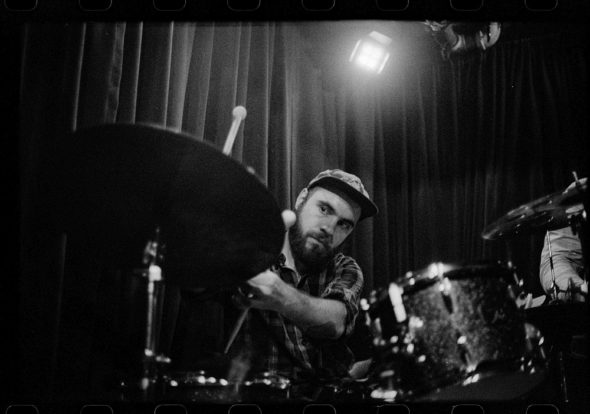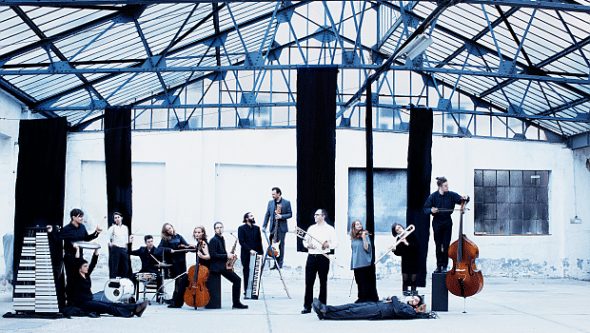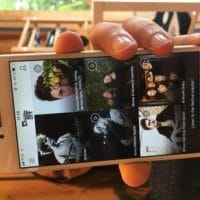
In two ways, the INT. JAZZFESTIVAL SAALFELDEN differs from the broad mass of festivals: The proportion of Austrian acts is traditionally high, and the courage for experimentation is traditionally a great one. This year the jazz festival turns 40. In a conversation with Markus Deisenberger, Artistic Director MARIO STEIDL explained how he wants to create new spaces for encounters and be a door-opener unto the international scene for Austrian acts.
“No idea where that will be going to, but that’s what we’re here for.”
This year you are celebrating your 40th anniversary. What kind of “specials” did you come up with to celebrate this anniversary?
Mario Steidl: In contrast to the 30th anniversary ten years ago when we invited Ornette Coleman, we decided this year not to celebrate the 40th anniversary with a review of our history and the worship of the great ones, but with a look into the future. By restructuring the whole thing.
What exactly does that mean?
Mario Steidl: There will be new stages and a new festival center. The main stage and the “Short Cuts” are of course preserved, because that is the core of the festival and therefore what the festival stands for. But I think that festivals have to be staged differently today. It’s no longer enough to stage just a concert series and invite bands to play on stage. It is necessary to create new spaces for encounters.
Participation is a huge topic. All festivals in Europe are thinking about “audience development”. That means: how can we connect with young people? How can we connect with new people? That’s exactly why we have created many new stages.

“It is important to give the musicians the freedom to decide for themselves where a particular project takes place.”
Which stages have been added?
Mario Steidl: I’ll try to explain that on the basis of the Artists in Residence. These are this year Maja Osojnik and Lukas König. In addition, there is the opening project on the main stage, an annual commission for the composition of a musical work, which this year was given to Manu Mayr. Now, especially with regard to the promotion of Austrian music, we have often faced the dilemma that on the one hand there’s really a lot of fantastic music around, but no real stage for it, either because the main stage is still too big for a particular act or because some projects just need smaller frames to work in. That’s why I said to the Artists in Residence, they should first come here, walk through Saalfelden and then tell me where they would like to do something. In other words, we go the opposite way to the usual concept where the festival director thinks something up and then sends the people there. It is not important where I see that a particular project should happen, but where the artist sees it. It is important to give the musicians the freedom to decide for themselves where a particular project takes place. This led to the idea of having Maja Osojnik perform on several stages.

There is for example, an old, empty courthouse, the former district court, which was made available to us, where Maja will work with installations. It opens with a performance, resulting in an installation that remains over the festival duration, the place being virtually constantly recorded and constantly being changed by Maja. At the same time Lukas König will find a stage there, where he will present several projects together with other artists. With two other artists Maja Osojnik will produce scores in a bookbindery with an in-house printing workshop, which are then presented in a performance. At the same time, a park, which we also have at our disposition, will be used to allow musicians to invite other musicians to play together. Short interventions, improvisations and sessions. We would like to give musicians the opportunity to spontaneously or in a planned way to meet people with whom they have never played before, to implement something together, which may also result in new projects. It’s about giving artists the opportunity to flourish and give the audience the opportunity to get to know the full range, or at least part of the work of an artist. Especially Maja and Lukas are involved in so many different projects and are so busy that this is usually very hard to believe.
Lukas König plays in the court three times, once in the park, once in the shortcuts. Five or six concerts. Maja Osojnik is constantly on duty for five days, and all this happens with free access for the public. We have been striving to give the entire stages around a low-threshold access as much as possible. The idea is that people who have little ideas of jazz and improvisation get the opportunity to immerse themselves in the music. Especially in this day and age where the value of music is in a free fall because music is available on Spotify and YouTube and is omnipresent, hardly anyone will buy a ticket for demanding music for around 30 euros, if otherwise it costs little to nothing. That is why it is more important than ever to offer sophisticated music with a low-threshold access.

Are there any other changes?
Mario Steidl: Yes, more than enough. I don’t know where to start. The forecourt is being redesigned. The stale Gastro tent will be done away with. The square will be fitted with a casual stage, with a total of twelve concerts there for three days. Gastronomically speaking, the whole thing is orchestrated by food trucks. We are creating a space where people of different backgrounds can meet. A place where you feel comfortable, which is casual and where one can meet others. As the crow flies one hundred meters from the main stage, there is a park that once was beautiful, where families used to come, but where, for some unknown reason, nothing is happening anymore today. DJs will perform there for three days and we shall deliberately put on improvised slots to confront people with music or to give people the opportunity to discover new music and get involved in it.
What gave you the impetus to change something?
Mario Steidl: The impetus was that I spent a lot of time at festivals over the last two years. You get into networking, you discuss with others how to position yourself and how to position artists in a better way. Very quickly a certainty establishes itself that you do not want to program a music line-up for another twenty years, but that you want more, that you want to break up the closed shop a bit.
What about the musical styles? Is something changing there?
Mario Steidl: In the genres World, Folk, Pop, Blues, Rock, a lot has been going on over the last few years and there will be many more additional concerts, also to show the local broad range, but it must also be possible to get to know jazz and impro. That’s what we stand for.
But if you’re programming someone like Mette Rasmussen with challenging noise-impro, it’s not really going to be a closed shop, is it?
Mario Steidl: This will happen as a “Short Cut” on the main stage. That’s where people come to on purpose. But when Lukas König meets a couple of people for a session in the park, people will come who would otherwise not go to a concert. They are given the opportunity to discover something and let themselves go. A young person who has no sense of jazz will hardly buy a ticket for Mette Rasmussen.
On the other hand, there are artists who come to Saalfelden again and again. Théo Ceccaldi, for example, played last year. This year he returns with a completely different project. I suppose there’s an idea behind that as well?
Mario Steidl: Quite rightly so. It is also an intention to follow the careers of musicians. Especially those who are at the height of their creativity. Ceccaldi was on the main stage with Freaks, a bigger project last year, which was very bombastic and did a great job. This year, I consciously present him in a completely different context. In a duo. Something like that can be found again and again: Binker Golding, Sarah Tandy etc. There are five, six acts from the London area. I came across Binker Golding through his duo album “Binker & Moses”. But it was not possible to program both of them together because they had different schedules. Golding then contacted me and suggested a project: “I always wanted to play with Wolfgang Mitterer,” he said. He wanted a carte blanche from me, to create with Mitterer and others a collective project on the main stage. No idea where that will be going to, but that’s what we’re here for. In Sarah Tandy he’s part of the project and with Elliot Galvin he plays in a duo. And that’s exactly what it’s all about: presenting a musician who moves in different formations and contexts just as who he is.
“We enjoy a great deal of trust from the audience.”
Music manager Berthold Seliger’s new book is called “Vom Imperiengeschäft” [On the business of imperia]. It’s about the commercial concert business, where apart from money, nothing else seems to be of any importance. At least regarding the pop/rock industry the truth is: Whether you go to Budapest, Vienna or Cologne, the line-ups are the same. What distinguishes one place from the other is at most the sponsoring beer brand. Your festival lives by the fact that it has always been staged as an antithesis to this festival industry. Or how do you see this?
Mario Steidl: Exactly. We are taking the step towards more individuality, towards empowerment and development. We live in an age in which online services become organizers. Specifically: Spotify is starting to organize because they see that, for example, in Mainz there is an above-average number of Jamie Cullum fans. If Cullum is in Europe, there will be an extra concert there because it surely will be sold out. In the course of digitization, completely new possibilities have opened up. New strategies. But we want to realize the exact opposite: away from the big crowd. But I can’t complain either. In the first week, without a fully completed program, we already sold half of the available tickets. We enjoy a great deal of trust from the audience. People know that they see things here which they otherwise will not be able to see. They know that we do not stage old stuff which anyway has all been seen countless times before. Things that you program because you want to have seen them once, but for that you will need 50,000 to 60,000 euros. I don’t feel like that. I’d rather put all this money into a holistic concept and young aspiring people.
You already have mentioned that on the one hand there’s the big stage, on the other hand there are also small stages. This year – contrary to the custom of the last few years, when the opening concert always had a big band character – Manu Mayr opens in an intimate cast with Susanna Gartmayer. Did you have to swallow for a second?

Mario Steidl: That’s really unusual. But he has already played a solo bass concerto here in front of three hundred people. There he managed to create a great arch of suspense, so that I’m totally confident. I do not tell him what he has to do. We already had solo and duo projects on the main stage too.
If you bring people from other areas such as Frode Haltli and Mette Rasmussen, there are also disturbed reactions or is this received mostly positive?
Mario Steidl: The latter. But there always are discussions. That one guy goes out and says that it was the best thing he has ever seen, and his neighbour goes out and says that it just was bad, that always happens, of course. You can discuss this happily with a drink at the bar table. What is jazz? What is jazz allowed to do? There are hardly any jazz purists around anymore. The program should meet different tastes. Something relaxing like Haltli, whose music makes you close your eyes and makes you believe you are drifting through the fjords, should happen. But something demanding like Rasmussen too.
“Austrian acts are represented on all stages.”
The Austrian scene is currently very broad and of a high quality, right?
Mario Steidl: Absolutely, and I am also an organizer who programs many Austrians. When you get funds from the public authorities, I also see it as an obligation to host a large part of the local scene. Wednesday will open with Wolfgang Puschnig and the Sketchbook Quartet, the Short Cuts by Daniel Riegler’s Studio Dan. Austrian acts are represented on all stages. We already talked about the Artists in Residence and Manu Mayr’s project. In addition, Lorenz Raab plays with RaaDie, in a duo with Sylvie Courvoisier and during the hike. Christian Muthspiel is coming with a large project which gender-related is casted very equally. The group Buntspecht and others from the young scene are following up. Other Austrian acts include Steph Kondert, Lylit, Marina and The Kats, Juetz. Lukas Kranzelbinder organizes the Flashmob project “Bass to the people”, the music hike and the Impro Session on Sunday.

It’s important that you show it all. However, our cooperation with Austrian Music Export [mica – music austria and the Austrian Music Fund (Öst.Musikfonds)], with which we aim to place some of these acts internationally, is also important, and it works very well too. We had for example an exchange with Finland. In other words, Finnish musicians played here, in return Elektro Guzzi, Mario Roms Interzone and Kompost 3 played in Finland. We also had an exchange with the Ljubljana Festival in Slovenia. So we try to use the window to internationality. In general, we have a lot of organizers here and we also make them meet the musicians who are here, invite specific organizers, where we see the greatest opportunities that they book Austrian artists at their festivals.
You briefly mentioned the English scene with a. o. Sarah Tandy and Binker Golding. These are all people one will hear from for a long time and a lot. The jazz scene in England is currently booming, finding a good connection to the club scene there. Is there anything to pick up or learn from that?
Mario Steidl: That’s hard to compare. Many acts like Nubya Garcia, Shabaka and the Ancestors etc. are very groove oriented. For some, I don’t understand the hype, but others I think are really good, so I wanted them here too. What you can learn or pick up perhaps, is that you can reach young people with groovy music and that jazz should not always come along too intellectually, but also be allowed to groove, as they say. But our acts are good at that too.
A final word?
Mario Steidl: Yes, one thing is really dear to me. Reactivating places that were previously abandoned, such as an abandoned park or a vacant courthouse, also raises the question of why nothing happens in such places. There could be many playgrounds for young people. There are many empty buildings with many empty rooms. Why don’t you make them available for young people who can do their own thing there through “co-working spaces”, art projects, pop-up stores, etc. A building in the middle of the city that could be the starting point for a great deal of things. Maybe one should think about making something out of such places again.
Thank you very much for the conversation!
Markus Deisenberger
Translated from the German interview by Julian Schoenfeld.

The International Jazzfestival Saalfelden is available as an app for your smartphone. Download the app called “JFS” in your app-store for Android or Apple devices.
Links:
Jazzfestival Saalfelden (Website)
Jazzfestival Saalfelden (Facebook)
Jazz from Austria (article & brochure)
